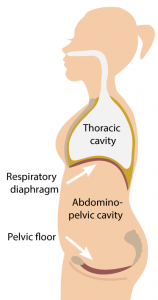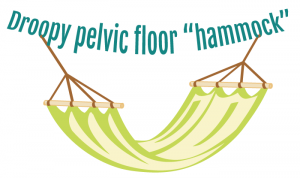When Can You Feel Baby Outside of Belly
Let me ask y'all a question: if a bowl of ice cream tastes expert, would a bucket be fifty-fifty improve? Whenever ane of my yoga clients encounters a yoga pose that challenges her, yet feels rewarding to conquer, she says: "That was great – lets do it every time!" I retrieve y'all know where I am going with this – if something feels good and/or appears to be useful we tend to crank it upward in hopes that the more than we do it, the more benefit we will get. This applies to the abdominal date as well. We might read about the benefits of the core appointment, then notice it useful in our yoga practice and the next thing we know nosotros proceed pulling our stomachs in everywhere we become in hopes of maximizing the benefit. Just similar with the ice foam example, information technology doesn't work that manner. Here is why.
 If your abdomen is a container, so it needs to have a top and a lesser to contain and protect its contents. In your torso the bottom of the container is formed by the pelvic floor muscles and the lid is the diaphragm. Your abdominal cavity is packed pretty tight with organs, specially the digestive organisation, and even though each organ has its designated location, they can also slide around when the content of your abdominal cavity gets squeezed.
If your abdomen is a container, so it needs to have a top and a lesser to contain and protect its contents. In your torso the bottom of the container is formed by the pelvic floor muscles and the lid is the diaphragm. Your abdominal cavity is packed pretty tight with organs, specially the digestive organisation, and even though each organ has its designated location, they can also slide around when the content of your abdominal cavity gets squeezed.
You know how when you cough or laugh hard you might feel like yous peed a little? (And if you are pregnant, y'all probably did 🙂 ) This is because during cough your abdominal muscles contract increasing intra abdominal pressure, which ways that your internal organs get squished a bit more than and push up against your diaphragm and downward against your pelvic flooring (and the organs located there, such as bladder). Like increase in intra intestinal pressure happens every fourth dimension you contract your abdomen at will.
 And then if you decide to keep your abdomen engaged all the time, you will be continuously pressing your organs against the diaphragm (which will limit its range of movement) and the pelvic floor (which might weaken it). You know how you can eat so much at a Thanksgiving dinner that it makes it hard to exhale? This happens because the content of your digestive system expands and limits the downward movement of the diaphragm on the inhale; as a upshot you might become shortness of breath. If yous do it often enough, it will go harder and harder to take deep breaths considering the diaphragm (being a muscle) volition non movement down as willingly. Studies show that increases in intra abdominal pressure tin bear upon both your breathing and your cardiovascular health. Now, I am not saying that practicing abdominal corset all the time will cause heart problems – that is going manner to far. Just keeping the intra intestinal pressure high all the time will bear on your breathing for certain.
And then if you decide to keep your abdomen engaged all the time, you will be continuously pressing your organs against the diaphragm (which will limit its range of movement) and the pelvic floor (which might weaken it). You know how you can eat so much at a Thanksgiving dinner that it makes it hard to exhale? This happens because the content of your digestive system expands and limits the downward movement of the diaphragm on the inhale; as a upshot you might become shortness of breath. If yous do it often enough, it will go harder and harder to take deep breaths considering the diaphragm (being a muscle) volition non movement down as willingly. Studies show that increases in intra abdominal pressure tin bear upon both your breathing and your cardiovascular health. Now, I am not saying that practicing abdominal corset all the time will cause heart problems – that is going manner to far. Just keeping the intra intestinal pressure high all the time will bear on your breathing for certain.
 Continuous pressure level on the pelvic flooring is not advisable either. The pelvic floor acts like a hammock that supports your intestinal contents and if information technology gets "droopy" it tin can pb to organ prolapse, urinary and bowel leakage, issues with sexual role and so on. Some of the reasons that lead to "droopy hammock" are pregnancy and childbirth, obesity, heavy lifting, high impact practise and chronic cough – as you tin can come across all of those activities involve the increase in intra intestinal pressure level. That is why, for example, it is usually recommended that you lot engage your pelvic floor muscles when you coughing. That is too why many yoga teachers suggest that you engage your pelvic flooring muscles simultaneously with progressive abdominal contraction during your yoga do. This is by and large a adept thought, except we tin can run into couple of issues here:
Continuous pressure level on the pelvic flooring is not advisable either. The pelvic floor acts like a hammock that supports your intestinal contents and if information technology gets "droopy" it tin can pb to organ prolapse, urinary and bowel leakage, issues with sexual role and so on. Some of the reasons that lead to "droopy hammock" are pregnancy and childbirth, obesity, heavy lifting, high impact practise and chronic cough – as you tin can come across all of those activities involve the increase in intra intestinal pressure level. That is why, for example, it is usually recommended that you lot engage your pelvic floor muscles when you coughing. That is too why many yoga teachers suggest that you engage your pelvic flooring muscles simultaneously with progressive abdominal contraction during your yoga do. This is by and large a adept thought, except we tin can run into couple of issues here:
- Nigh people demand to be taught how to appoint the pelvic flooring muscles properly; otherwise they might tense their buttocks, anus or legs, which doesn't help with support.
- Both contracting AND release are important, since we want to build the muscle tone without creating tension. It works best if you contract those muscles during exhalation, then maintain the contraction for few seconds as you hold the breath out and and so gradually release the contraction every bit you inhale. This is all-time washed in a seated position or in other simpler poses with consummate focus on what you are doing, otherwise information technology volition drown in the sea of other anatomical cues.
Then when should we engage the abdomen in our daily lives? Information technology is almost useful when we practise concrete activities that load our spines, whether it's exercising, lifting, throwing, rowing and then on. Enquiry shows that intra intestinal pressure " has a substantial spinal unloading effect for all directions of generated external moments" (including bending forward, back, sideways and twisting). The paper concludes: "These findings support the idea that intra-abdominal pressurization is beneficial considering it unloads the spine."
So to sum it up – most things are good in moderation. The abdominal contraction ("corset") that leads to an increase in intra abdominal pressure works well to back up the spine during challenging concrete activity, but information technology shouldn't be prolonged, as it can bear upon the depth of breathing and the tone of the pelvic floor muscles.
![]()
lapinskiflocruing.blogspot.com
Source: https://sequencewiz.org/2015/11/11/engage-the-abdomen-all-the-time/
0 Response to "When Can You Feel Baby Outside of Belly"
Post a Comment